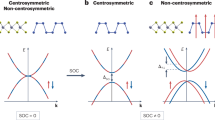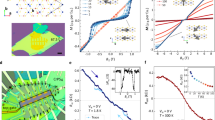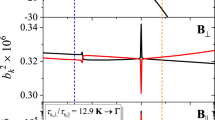Abstract
Graphene’s extremely small intrinsic spin–orbit (SO) interaction1 makes the realization of many interesting phenomena such as topological/quantum spin Hall states2,3 and the spin Hall effect4 (SHE) practically impossible. Recently, it was predicted1,5,6,7 that the introduction of adatoms in graphene would enhance the SO interaction by the conversion of sp2 to sp3 bonds. However, introducing adatoms and yet keeping graphene metallic, that is, without creating electronic (Anderson) localization8, is experimentally challenging. Here, we show that the controlled addition of small amounts of covalently bonded hydrogen atoms is sufficient to induce a colossal enhancement of the SO interaction by three orders of magnitude. This results in a SHE at zero external magnetic fields at room temperature, with non-local spin signals up to 100 Ω; orders of magnitude larger than in metals9. The non-local SHE is, further, directly confirmed by Larmor spin-precession measurements. From this and the length dependence of the non-local signal we extract a spin relaxation length of ∼1 μm, a spin relaxation time of ∼ 90 ps and a SO strength of 2.5 meV.
This is a preview of subscription content, access via your institution
Access options
Subscribe to this journal
Receive 12 print issues and online access
$259.00 per year
only $21.58 per issue
Buy this article
- Purchase on SpringerLink
- Instant access to full article PDF
Prices may be subject to local taxes which are calculated during checkout




Similar content being viewed by others
References
Castro Neto, A. H. & Guinea, F. Impurity-induced spin–orbit coupling in graphene. Phys. Rev. Lett. 103, 026804 (2009).
Kane, C. L. & Mele, E. J. Z(2) topological order and the quantum spin Hall effect. Phys. Rev. Lett. 95, 146802 (2005).
Kane, C. L. & Mele, E. J. Quantum spin Hall effect in graphene. Phys. Rev. Lett. 95, 226801 (2005).
Hirsch, J. E. Spin Hall effect. Phys. Rev. Lett. 83, 1834–1837 (1999).
Schmidt, M. J. & Loss, D. Edge states and enhanced spin–orbit interaction at graphene/graphane interfaces. Phys. Rev. B 81, 165439 (2010).
Conan, W., Jun, H., Jason, A., Marcel, F. & Ruqian, W. Engineering a robust quantum spin Hall state in graphene via adatom deposition. Phys. Rev. X 1, 021001 (2011).
Zhou, J., Liang, Q. F. & Dong, J. M. Enhanced spin–orbit coupling in hydrogenated and fluorinated graphene. Carbon 48, 1405–1409 (2010).
Rappoport, T. G., Uchoa, B. & Castro Neto, A. H. Magnetism and magnetotransport in disordered graphene. Phys. Rev. B 80, 245408 (2009).
Seki, T. et al. Giant spin Hall effect in perpendicularly spin-polarized FePt/Au devices. Nature Mater. 7, 125–129 (2008).
Novoselov, K. S. et al. Electric field effect in atomically thin carbon films. Science 306, 666–669 (2004).
Lee, C., Wei, X. D., Kysar, J. W. & Hone, J. Measurement of the elastic properties and intrinsic strength of monolayer graphene. Science 321, 385–388 (2008).
Kim, E. A. & Castro Neto, A. H. Graphene as an electronic membrane. Europhys. Lett. 84, 57007 (2008).
Loh, K. P., Bao, Q. L., Ang, P. K. & Yang, J. X. The chemistry of graphene. J. Mater. Chem. 20, 2277–2289 (2010).
Elias, D. C. et al. Control of graphene’s properties by reversible hydrogenation: Evidence for graphane. Science 323, 610–613 (2009).
Nair, R. R. et al. Fluorographene: A two-dimensional counterpart of teflon. Small 6, 2877–2884 (2010).
Fert, A. & Levy, P. M. Spin Hall effect induced by resonant scattering on impurities in metals. Phys. Rev. Lett. 106, 157208 (2011).
Wunderlich, J., Kaestner, B., Sinova, J. & Jungwirth, T. Experimental observation of the spin-Hall effect in a two-dimensional spin–orbit coupled semiconductor system. Phys. Rev. Lett. 94, 047204 (2005).
Kuemmeth, F., Ilani, S., Ralph, D. C. & McEuen, P. L. Coupling of spin and orbital motion of electrons in carbon nanotubes. Nature 452, 448–452 (2008).
Jespersen, T. S. et al. Gate-dependent spin–orbit coupling in multielectron carbon nanotubes. Nature Phys. 7, 348–353 (2011).
Kato, Y. K., Myers, R. C., Gossard, A. C. & Awschalom, D. D. Observation of spin Hall effect in semiconductors. Science 306, 1910–1913 (2004).
Dyakonov, M. I. & Perel, V. I. Current-induced spin orientation of electrons in semiconductors. Phys. Lett. A 35, 459–460 (1971).
Valenzuela, S. O. & Tinkham, M. Direct electronic measurement of the spin Hall effect. Nature 442, 176–179 (2006).
Abanin, D. A. et al. Giant nonlocality near the Dirac point in graphene. Science 332, 328–330 (2011).
Brüne, C. et al. Spin polarization of the quantum spin Hall edge states. Nature Phys. 8, 485–490 (2012).
Ryu, S. et al. Reversible basal plane hydrogenation of graphene. Nano Lett. 8, 4597–4602 (2008).
Jaiswal, M. et al. Controlled hydrogenation of graphene sheets and nanoribbons. ACS Nano 5, 888–896 (2011).
Cancado, L. G. et al. Quantifying defects in graphene via Raman spectroscopy at different excitation energies. Nano Lett. 11, 3190–3196 (2011).
Hornekaer, L. et al. Clustering of chemisorbed H(D) atoms on the graphite (0001) surface due to preferential sticking. Phys. Rev. Lett. 97, 186102 (2006).
Abanin, D. A., Shytov, A. V., Levitov, L. S. & Halperin, B. I. Nonlocal charge transport mediated by spin diffusion in the spin Hall effect regime. Phys. Rev. B 79, 035304 (2009).
Mihajlovic, G., Pearson, J. E., Garcia, M. A., Bader, S. D. & Hoffmann, A. Negative nonlocal resistance in mesoscopic gold Hall bars: Absence of the giant spin Hall effect. Phys. Rev. Lett. 103, 166601 (2009).
Tombros, N. et al. Electronic spin transport and spin precession in single graphene layers at room temperature. Nature 448, 571–574 (2007).
Yang, T-Y. et al. Observation of long spin-relaxation times in bilayer graphene at room temperature. Phys. Rev. Lett. 107, 047206 (2011).
Avsar, A. et al. Toward wafer scale fabrication of graphene based spin valve devices. Nano Lett. 11, 2363–2368 (2011).
Patra, A. K. et al. Dynamic spin injection into chemical vapor deposited graphene. Appl. Phys. Lett. 101, 162407 (2012).
McCreary, K. M., Swartz, A. G., Han, W., Fabian, J. & Kawakami, R. K. Magnetic moment formation in graphene detected by scattering of pure spin currents. Phys. Rev. Lett. 109, 186604 (2012).
Kettemann, S. Dimensional control of antilocalization and spin relaxation in quantum wires. Phys. Rev. Lett. 98, 176808 (2007).
Paul, W. & Stefan, K. in Handbook of Nanophysics: Nanotubes and Nanowires Ch 28 (CRC Press, 2010).
Huertas-Hernando, D., Guinea, F. & Brataas, A. Spin–orbit-mediated spin relaxation in graphene. Phys. Rev. Lett. 103, 146801 (2009).
Ochoa, H., Castro Neto, A. H. & Guinea, F. Elliot–Yafet mechanism in graphene. Phys. Rev. Lett. 108, 206808 (2012).
Konschuh, S., Gmitra, M. & Fabian, J. Tight-binding theory of the spin–orbit coupling in graphene. Phys. Rev. B 82, 245412 (2010).
Duplock, E. J., Scheffler, M. & Lindan, P. J. D. Hallmark of perfect graphene. Phys. Rev. Lett. 92, 225502 (2004).
Maekawa, S. (ed.) in Concepts in Spin Electronics Ch. 8, 363–367 (Oxford Univ. Press, 2006).
Acknowledgements
We thank A. Avsar, A. Pachoud, J. You and M. A. Cazalilla for their help and useful discussions. This work was supported by the Singapore National Research Foundation Fellowship award (RF2008-07-R-144-000-245-281), the NRF-CRP award ‘Novel 2D materials with tailored properties: beyond graphene’ (R-144-000-295-281) and the Singapore Millennium Foundation-NUS Research Horizons award (R-144-001-271-592; R-144-001-271-646).
Author information
Authors and Affiliations
Contributions
B.Ö. devised and supervised the project. J.B. and B.Ö. designed the experiments. J.B. and G.K.W.K. performed the experiments. A.H.C.N. provided the theoretical work. All authors carried out the data analysis and discussed the results. J.B., A.H.C.N. and B.Ö. co-wrote the paper.
Corresponding author
Ethics declarations
Competing interests
The authors declare no competing financial interests.
Supplementary information
Supplementary Information
Supplementary Information (PDF 781 kb)
Rights and permissions
About this article
Cite this article
Balakrishnan, J., Kok Wai Koon, G., Jaiswal, M. et al. Colossal enhancement of spin–orbit coupling in weakly hydrogenated graphene. Nature Phys 9, 284–287 (2013). https://doi.org/10.1038/nphys2576
Received:
Accepted:
Published:
Issue date:
DOI: https://doi.org/10.1038/nphys2576
This article is cited by
-
Photoexcitation-induced spin dynamics in 1T-VSe2 investigated by ab initio nonadiabatic molecular dynamics
Science China Materials (2024)
-
Long-range nontopological edge currents in charge-neutral graphene
Nature (2021)
-
Coexistence of large conventional and planar spin Hall effect with long spin diffusion length in a low-symmetry semimetal at room temperature
Nature Materials (2020)
-
Observation of spin-polarized Anderson state around charge neutral point in graphene with Fe-clusters
Scientific Reports (2020)
-
Spintronics in Two-Dimensional Materials
Nano-Micro Letters (2020)



